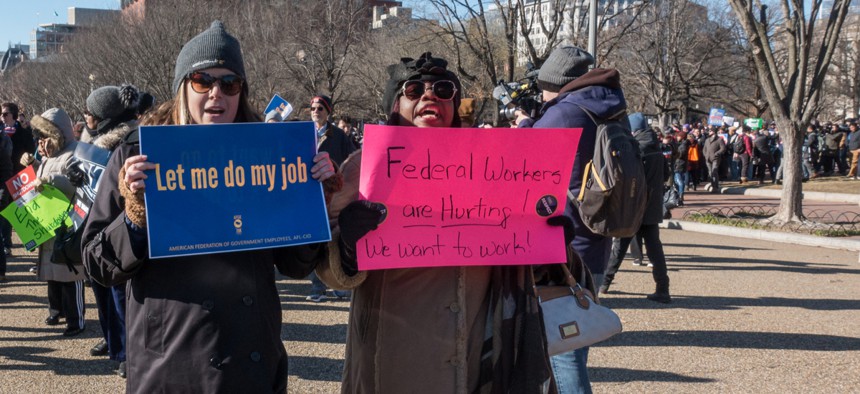Agencies Paid Federal Employees $3.7 Billion Not to Work During Recent Shutdowns

Furloughed and unpaid federal workers protest the government shutdown in D.C. Jan. 10, 2019. bakdc/Shutterstock.com
One department lost 90 employees during the most recent lapse, while another slashed hiring by nearly 40%.
The federal government wasted $4 billion over the last three government shutdowns, according to a new report, including $3.7 billion that went to federal employees who were sent home and prohibited from working but later granted back pay.
Agencies spent an additional $338 million on administrative work, lost revenue and late fees on interest payments due to the shutdowns, Sens. Rob Portman, R-Ohio, and Tom Carper, D-Del., found on behalf of the Senate Homeland Security and Governmental Affairs Committee panel on investigations. The three shutdowns totaled 52 days over the last six years. Federal workers cumulatively spent nearly 15 million days on furlough, which amounted to 57,000 years of lost productivity.
About 350,000 federal employees were furloughed during the record-setting 35-day shutdown that ended earlier this year, while about 850,000 were sent home during the 16-day shutdown in 2013.
The figures in the Senate report actually represent a conservative estimate, as the Agriculture, Defense, Justice and Commerce departments, as well as the Environmental Protection Agency, were unable to provide data to the senators. That failure, Portman and Carper said, “raises serious questions about these agencies’ ability to perform any oversight of [their] own employees.” While the Pentagon was unaffected by the more recent shutdown, Defense initially furloughed 400,000 employees in 2013 before eventually recalling virtually all of them. Commerce, Justice, USDA and EPA furloughed 109,000 employees earlier this year, representing more than 30% of the total number of workers sent home.
American taxpayers incur the tab not just from paying feds not to work and other costs associated with shutdowns, the senators said, but also due to the “significant lost productivity costs” and “important functions” that are not performed. The senators noted several such examples, including:
- Investigators at Justice, Treasury, the Securities and Exchange Commission, and Federal Trade Commission were unable to pursue leads or bring enforcement actions against bad actors. The FTC identified a fraudulent immigration-related scam that began during the shutdown, for example, but was unable to notify consumers or monitor developments.
- The Consumer Product Safety Commission did not recall potentially dangerous products during the shutdown. The senators noted on Feb. 5, 2018, that CPSC issued a recall notice for a drill for a shock hazard issue the company had flagged weeks earlier, on Jan. 10.
- Justice canceled 60,000 immigration hearings, extending the already significantly delayed case backlog.
- Smithsonian Institution facilities were forced to close during the shutdowns in 2013 and 2018-2019. During the more recent closures, the agency estimated it lost $4.3 million in revenues from stores, cafes, theaters and the cancellation of special events, which Smithsonian Secretary David Skorton told the senators “can never be recovered.” Smithsonian estimated 1.1 million people were unable to visit museums and important research, such as “critical periods of animal breeding,” were disrupted.
In addition to furlough and back pay data, the senators requested information on the impact on contractors; administrative costs such as developing contingency plans and restarting normal operations upon reopening; miscellaneous costs and effects such as canceled travel, delayed contracts, disrupted law enforcement activities, delayed disbursement of grant funds, and halted permitting and approvals; and long-term effects.
At Treasury, for example, the department is now facing data gaps for international capital, an important economic indicator. The State Department, meanwhile, spent more than $18 million preparing for and monitoring the recent shutdown. State spent an additional $4 million getting operations back to normal once the government reopened and lost a net of 90 civil service employees during the funding lapse. At the Transportation Department, the Federal Transit Administration ceased distributing grant funds to entities across the country and the Federal Aviation Administration cited the shutdown when slashing its projected fiscal 2019 hiring by 37%.
The Congressional Budget Office found earlier this year the shutdown led to $11 billion in lost economic activity, $3 billion of which would never be recovered. Carper said the "far-reaching" effects of shutdowns demonstrate that Congress must act quickly before its current Sept. 30 deadline to avoid another spending lapse.
“Government shutdowns are avoidable failures of governance that hemorrhage taxpayer dollars, put our nation’s federal agencies in organizational and financial disarray and pose risks to our national security," the senator said. "The impacts can be felt in every corner of our country, in red states and blue states alike."
Portman and Carper called on Congress to pass legislation that would permanently end shutdowns by automatically initiating a continuing resolution whenever lawmakers fail to enact appropriations. They also called on the Office of Management and Budget to examine why some agencies failed to provide complete information and inform Congress if legislation is needed to ensure that data is readily available.
"Federal government shutdowns don’t save money, they actually cost taxpayers billions of dollars,” Portman said. “It’s time to end government shutdowns for good."






